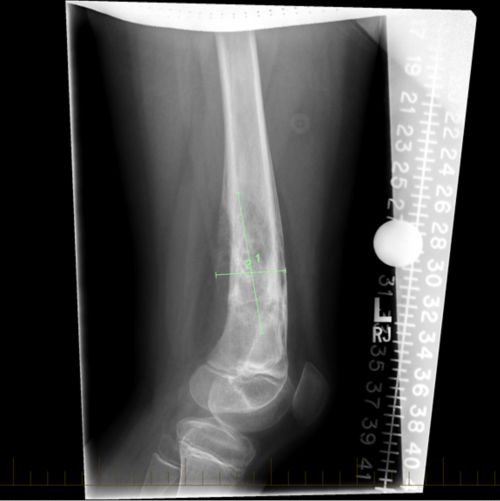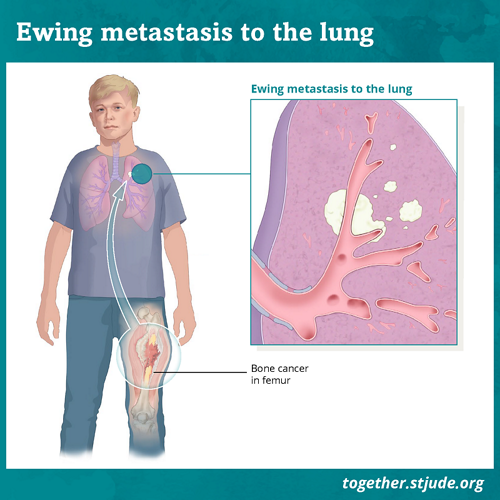Menu
Close
Back
Welcome to
Together is a new resource for anyone affected by pediatric cancer - patients and their parents, family members, and friends.
Learn More
Ewing sarcoma is a type of cancer that grows in bones or in the soft tissue around bones.
Ewing sarcoma is a type of cancer that grows in bones or in the soft tissue around bones. It often occurs in the leg, pelvis, ribs, or arm.
Ewing sarcoma is the second most common type of pediatric bone tumor. But it is rare. Only about 200 children and young adults are diagnosed with Ewing sarcoma in the United States each year.
Ewing sarcoma is more common in older children and teens.
If the cancer is caught before it spreads, the chance of long-term survival is about 70%. If the cancer has already spread, the chance of a cure is about 30%.
Ewing sarcoma is usually treated with chemotherapy, surgery and/or radiation. Patients can have treatment that has already been studied in clinical trials. Or they may get treatment that is being studied at the time of diagnosis.
Symptoms of Ewing sarcoma depend on where the tumor is located. Symptoms might include:
Sarcomas are cancer found in the bone and soft tissue of the body. Watch this video to learn about sarcoma symptoms, diagnosis, and treatment in children.
Pain can get worse over weeks or months. It may even cause your child to wake up at night.
The signs and symptoms of Ewing sarcoma often start out like normal childhood aches and pains. This means that it can take a while before Ewing sarcoma is diagnosed.
We do not know why children and young adults develop Ewing sarcoma. But certain factors can increase the risk. These factors include:
Ewing sarcoma does not seem to be passed down in families.

X-ray of a child’s femur showing the size of the Ewing sarcoma
Doctors use several procedures and tests to diagnose Ewing sarcoma. These include:
Although other cancers are classified as stages 1–4, Ewing sarcoma is classified as either localized or metastatic.
Localized means there is a tumor in only 1 place in the body.
Metastatic means the cancer has spread to 1 or more places. These might include:
About 25% of patients have metastatic disease when they are diagnosed. In about half of those patients, the disease has spread to the lungs.

Ewing sarcoma is usually treated with chemotherapy followed by surgery and more chemotherapy. Radiation therapy may be used in place of surgery or added to the treatment.
Clinical trials are studying new treatments for Ewing sarcoma. These include targeted therapy and immunotherapy.
Ewing sarcoma has 3 main treatment goals:
Survival of Ewing sarcoma depends on several factors:
Patients who have chemotherapy and a single, localized Ewing sarcoma tumor that can be completely removed with surgery have a 70% chance of long-term cure in the United States.
Patients who have cancer that has spread to distant parts of the body at diagnosis have a 15–30% chance of survival, depending on where the cancer has spread.
The prognosis for patients with recurrent Ewing sarcoma is poor. The chance of cure after the cancer has returned (relapsed) is around 10–15% in the U.S.
Patients with recurrent Ewing sarcoma often develop new tumors within the first 2 years of diagnosis. This most often occurs as new growths in the lungs.
Patients who have early recurrence (their Ewing sarcoma comes back within 2 years of diagnosis) are much harder to cure than those who have later recurrence.
Balancing quality of life with cancer-directed therapy is important. Talk to your care team about problems to expect and how to help manage them. Palliative care can help families manage symptoms, promote quality of life, and make informed decisions.
Ewing sarcoma can come back years into survivorship. But it is most common within the first 2 years after treatment ends. The tumor can come back in the same place or in another part of the body.
Your child will need follow-up care to screen for recurrence for a long time after treatment ends. The care team will suggest types of tests and how often they should be done. Imaging tests usually include:
If your child has had Ewing sarcoma in the bone marrow, the care team may also suggest bone marrow tests.
Most patients who have an amputation or limb-sparing surgery do well over time.
They report good physical function and quality of life. Follow-up care is important.
Your child should have an annual exam to check muscle and bone function. It is important to make sure there are no ongoing problems. Uneven limb length, changes in the way your child walks, joint issues, or other problems can cause chronic pain or disability.
Children treated for Ewing sarcoma are at risk side effects related to therapy. Your child needs to have regular physical checkups and screenings. Living a healthy lifestyle with healthy eating habits can help, too.
Survivors of bone cancer tend to be less active. Regular exercise is important to maintain health, fitness, and physical function.
If your child had systemic chemotherapy or radiation, they need to be monitored for acute and late effects of therapy. Problems due to treatment may include:
Radiation to the leg can affect growth in that bone. It can cause the leg to be shorter. This may result in unequal leg length. There are different ways to treat this problem, depending on the severity.
Your child’s care team should give you a survivorship care plan after treatment ends. This report will include needed screening tests and tips for a healthy lifestyle.
Talk to your child’s health care provider about late effects of treatment. Always follow the instructions from your care team.
—
Reviewed: July 2023